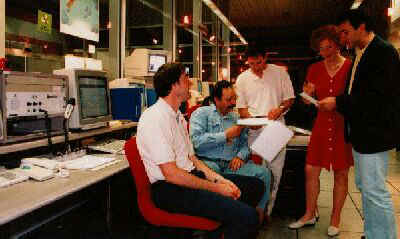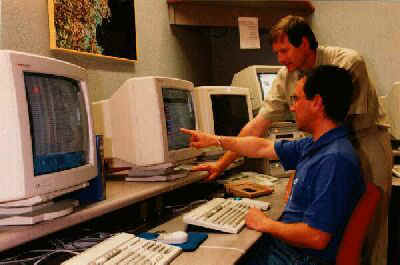For the operations control centre, or CMP, each new
day begins . . . the day before!
For the CMP, located at the Toulouse Space Centre, most of the tasks involved in
controlling the orbiting satellite are performed automatically by computers. To ensure
that the computers are programmed correctly, the operators must always be one day
ahead : today they are working on the instructions that will be automatically
executed tomorrow and so on, day after day.
Provision must, however, be made for manual control should the
automatic systems fail. The CMP operators are organized into teams so that one is always
available should a problem arise.
Routine control operations are performed by the CNES operations
team. The five controllers making up the team take turns at manning the CMP between
06:00 and 24:00 UTC every day of the year. In the event of a problem, they are always the
first to know. It is then their job to apply the first-response procedures applicable to
each anomaly.
The second tier contributing to problem resolution comprises teams of engineers organized
according to their areas of special knowledge (satellite, computing, and mission). Members
of these teams are constantly on call to provide technical support within the hour at any
time of day or night.
Activities at the CMP are organized around two work cycles :
- one determined by satellite passes (approximately five passes of ten minutes each per
day), the duration and time of each varying over a 26-day cycle defined by the satellite
orbit;
- the other by the regular dialogue sessions between the Spot Image programming centre and
the passenger programming centres resulting in the compilation of the daily imagery
acquisition programme and passenger work programmes.
The two work cycles come together at around 23:00 when the CMP uploads the coming day's
programming commands as the satellite passes over the Aussaguel station near Toulouse.
This marks the end of the CMP's working day. But the next day has already begun with the
compilation of the day's workplan and the filing of a request to use the 2-GHz TT&C
network over the coming days in coordination with other network users.
The day's events
As soon as the day's first pass begins (around 07:00), the controller
scans the main status indicators : anomaly counter, bus and payload modes, etc.
Normally, all is in ordre, no anomalies were observed since the last contact with a
TT&C station and the acquisition program has been executed as planned.
As soon as contact is established, the first pass of the day is used to update the
orbit data in the onboard computer's memory so that the flight software can control the
satellite's attitude and adjust the activity schedule to the exact orbit.
Later that morning a dialogue session will be held between the CMP and the Spot Image programming centre. At the CMP end, this dialogue will be under
the authority of the mission engineer representing the CMP for all issues
involving the programming centre. In the event of a difficulty in putting together the
imagery acquisition program, the mission engineer will be called in to resolve the issue.
 In
the early afternoon, (2 pm), the operational coordination group, or GCO,
meets. Each area of expertise (onboard segment, ground segment, mission,
operations) is represented. The specialists describe the status of the
subsystem(s) under their responsibility. Decisions are then taken concerning the
operations planned for the days ahead.
In
the early afternoon, (2 pm), the operational coordination group, or GCO,
meets. Each area of expertise (onboard segment, ground segment, mission,
operations) is represented. The specialists describe the status of the
subsystem(s) under their responsibility. Decisions are then taken concerning the
operations planned for the days ahead.
The GCO meets every day at the same time and whenever an unexpected problem needs to be
coordinated by the CMP staff.
A little later on, the programming centre relays the acquisition program for the next
day to the CMP over a dedicated computer link.
As soon as the CMP receives the program it runs a series of checks then begins
converting it into commands directly executable by the satellite. This task is performed
under the watchful eye of the mission engineer.
 In
parallel, the controllers continue to monitor the satellite, each pass adding to the
database storing the spacecraft's engineering history since reaching its nominal orbit.
In
parallel, the controllers continue to monitor the satellite, each pass adding to the
database storing the spacecraft's engineering history since reaching its nominal orbit.
Later that evening, the work program, covering all of the
coming day's activities, is uploaded during a command uplink session. This is a
very important phase of the day's operations. An onboard segment engineer
is always on call, ready to help if there is the least difficulty establishing contact
with the satellite.
These operations are repeated every day, since launch, until the end
of its working life. From time to time, unexpected events occur, throwing
the regular cycles of events out of sync. The operational teams then have the task of
bringing things back to order as quickly as possible without compromising either the
satellite's health or the mission.
top of page, article

page updated on the 00-06-06
 In
the early afternoon, (2 pm), the operational coordination group, or GCO,
meets. Each area of expertise (onboard segment, ground segment, mission,
operations) is represented. The specialists describe the status of the
subsystem(s) under their responsibility. Decisions are then taken concerning the
operations planned for the days ahead.
In
the early afternoon, (2 pm), the operational coordination group, or GCO,
meets. Each area of expertise (onboard segment, ground segment, mission,
operations) is represented. The specialists describe the status of the
subsystem(s) under their responsibility. Decisions are then taken concerning the
operations planned for the days ahead. In
parallel, the controllers continue to monitor the satellite, each pass adding to the
database storing the spacecraft's engineering history since reaching its nominal orbit.
In
parallel, the controllers continue to monitor the satellite, each pass adding to the
database storing the spacecraft's engineering history since reaching its nominal orbit.